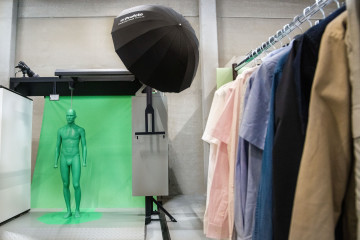Conscious
Come prenderti cura dei tuoi capi

We’re on a journey to make fashion smarter, giving fashion-lovers the best possible online retail experience and making sure every item of clothing is worn.
27 FEBRUARY 2022
Rinnoviamo sempre il nostro impegno per rendere migliore il nostro settore, offrendo agli amanti della moda l'esperienza di acquisto online migliore possibile e assicurandoci che ogni capo d'abbigliamento venga indossato. Perciò, abbiamo deciso di comunicare di più e raccontare il nostro percorso e le nostre scelte sostenibili per essere il più trasparenti possibile.
La moda è uno dei settori maggiormente responsabili dell'inquinamento e, purtroppo, il 12% dei capi prodotti rimane invenduto.
La nostra mission: All clothing should be worn.
Offriamo ai designer una piattaforma di vendita per assicurarci che ogni capo prodotto venga indossato.
In questo post, abbiamo raccolto 10 consigli facili da seguire per prenderti cura dei tuoi capi al meglio. Perché è così importante?
Una scelta migliore per il guardaroba Prendersi cura dei capi ne prolunga la vita e mantiene il tuo stile impeccabile più a lungo. E poi, ti fa risparmiare tempo!
Circa il 25% dell'impatto ambientale di un indumento è legato all'uso e al lavaggio.
Perciò, grazie ai nostri consigli, potrai valorizzare il tuo guardaroba rispettando le risorse del nostro Pianeta.
1. Indossa di più, lava di meno
Lava i tuoi capi solo quando necessario. Spesso, farlo dopo un solo utilizzo è più una questione d’abitudine che di igiene. Molti indumenti hanno solo bisogno di essere arieggiati, e le macchie spesso possono essere trattate in modo mirato. Sii responsabile e lava i tuoi indumenti più raramente: è un vantaggio per tutti.
2. Le temperature più basse sono altrettanto efficaci
Le lavatrici e i detersivi sono sviluppati per pulire a temperature più basse rispetto al passato. Il calore può spezzare le fibre tessili e consuma più energia, perciò scegli una temperatura più bassa e vedrai che i tuoi vestiti dureranno di più.
3. Riempila tutta
A meno che non si tratti di un’emergenza, lavare un capo solo in un programma completo di vari cicli è uno spreco sia d’acqua che di energia. Aspetta di avere abbastanza biancheria sporca da riempire ¾ della lavatrice. Non riempire troppo il cestello, però, perché impedisce all’acqua di portare via lo sporco, pulendo così meno bene i capi.
4. Evita l’asciugatrice
Così come è meglio far asciugare i capelli naturalmente, è meglio anche lasciar asciugare i vestiti all’aria! Mantiene i tuoi capi in migliori condizioni e, se lo fai correttamente, puoi risparmiare tempo che altrimenti avresti impiegato stirandoli. Usa delle grucce per appendere camicie e abiti di sartoria per assicurarti un’asciugatura come fossero già stirati.
5. Intervieni sulle macchie in modo tempestivo
Se uno dei tuoi capi si macchia, cerca di intervenire subito in modo mirato. Specialmente nel caso di materiali naturali come il cotone, il lino e la lana, che sono molto assorbenti, lasciare riposare la macchia la renderà più difficile da eliminare.
6. Congela i jeans
Mettere i tuoi jeans in una busta nel freezer per uno o due giorni li manterrà in condizioni migliori, eliminando batteri e odori. Che ne dici, hai posto vicino al gelato?
7. Quando esce il sole, fai uscire un po’ anche i tuoi capi
Il sole sbianca in modo naturale i vestiti. Stendi i tuoi capi bianchi ad asciugare al sole e approfittane!
8. Distendi i tuoi capi in lana per farli asciugare
Le superfici piane sono perfette per far asciugare gli indumenti a maglia, specialmente quelli più pesanti: aiuta a evitare che si sformino. Perciò, falli asciugare in piano, preferibilmente con sotto un asciugamano per assorbire l’umidità in eccesso.
9. Stira solo se proprio devi
Hai bisogno di un’altra scusa per evitare di stirare? Stendere i capi per farli asciugare invece di usare l’asciugatrice ti fa risparmiare anche l’energia consumata dal ferro da stiro. Se i tuoi vestiti sono già puliti e asciutti, appendili in bagno mentre fai la doccia. L’umidità agirà in modo simile al vapore del ferro da stiro, contribuendo a ridurre le pieghe.
10. Dedicati a piccole riparazioni
Un bottone mancante o un piccolo difetto non devono per forza indurti a buttare via un capo. Fanno semplicemente parte del ciclo di vita naturale dei prodotti, che possono essere facilmente riparati, prolungandone così la vita. Su Pinterest, YouTube e TikTok puoi trovare utili consigli sul fai da te. Se invece non hai voglia di cimentarti, potrai sempre trovare un amico o famigliare che si intende di riparazioni – o anche un fantastico sarto.
Tutto prima o poi finisce, anche la vita utile dei capi. Ma seguendo questi 10 semplici consigli, potrai sicuramente sfoggiarli più a lungo.
Se hai bisogno di qualche capo nuovo, esplora la nostra collezione.
#WearIt
More from Otrium
See all articles
Conscious
Otrium's Photo Studio
As we all know, visuals are everything when it comes to fashion. We can see that consumers are more likely to choose clothing with clear images. At Otrium, we understand the important role that visuals play in presenting clothing at its best, so here’s what we did: We've initiated our Photo Studio in 2020, to optimise the visual identity of the items on our platform. Our mission revolves around collaborating with brand partners to give a new life to their unsold stock through our platform. Our in-house Photo Studio captures these items on models using AI. Quick and effective From a seamless photo shoot to the final image, we manage it all, eliminating the need for third-party involvement and ensuring a swift and cost-effective workflow. A quick turnaround, with items going live within a week. The studio offers options between packshot and model images, with high-quality AI-driven modelling. This is how we workundefinedundefinedundefinedundefinedBest of both worlds Off-price items are mostly end of season, and for brands it is therefore less attractive to invest in such items. This is where Otrium comes in; for a small expense we deliver quality images of these fashion items if our brand partners do not have such imagery available themselves. These visuals help consumers with making an accurate purchase decision and therefore also reduce the likelihood that consumers will return their order.Capacity Behind the scenes, our statistics reveal the scale of our operations. In 2023 alone, 15,000 items were shot, with 2,500 as model photography. Our editing partner handled retouching for 30,000 images, emphasising the magnitude of our commitment to visual excellence. Orders with at most 75 items can go live within four days.
The Otrium Photo Studio isn't just about capturing images; it's a testament to our dedication to revolutionising how fashion is presented and experienced. With a commitment to efficiency, quality, and innovation, we're aiming to set new standards in the fashion industry.
Click undefined If you want to know more about Otrium’s services.

Conscious
Otrium's donations program
At Otrium, our goal is to ensure all clothing produced is worn. Over 90% of the items available on our platform reach our members. We offer alternative services to unburden fashion brands to repurpose the unsold 10%. Alongside our B2B Marketplace – where we connect our brand partners to local stock buyers – we actively support charities to repurpose the items while serving local communities.How it worksPreviously, Otrium would return unsold items to our brand partners, operating on a consignment basis where brands retain ownership until items find new owners through our platform's data-driven matching. Our donation service operates as an additional facet of our core mission, which involves giving unsold fashion items a renewed purpose. We enable these charities to select items upfront. To ensure that the items we send their way fit with the needs of their community. Partnerships with charities show us the importance clothing holds.

Conscious
Conscious Series: So Good To Wear
Otrium continually works towards the mission that all clothing should be worn. We do this by helping to eliminate unsold inventory and using technology and data to change the way clothing is created and sold. On our journey towards a smarter, more sustainable fashion industry, we’ve teamed up with Good On You, the leading source of fashion sustainability ratings. We’ve used their know-how to highlight brands on our own platform that go the extra mile to be more sustainable, which helps our customers make more informed shopping choices. Using Good On You’s data, we’ve introduced the Otrium Conscious filter. And now we’re speaking to conscious-rated brands carried by Otrium to find out more about their approach towards sustainability. This week, we chatted to Eric Otten, CEO of cashmere brand So Good To Wear, who believes that ethical fashion should be the rule instead of the exception. So what does sustainability mean to you? “People have always thought we could take something inexhaustible from our earth, to drive mass consumption and economic growth. Unfortunately, the reality is the opposite. Sustainability means that we have to give back more to the earth than we take” Tell us more about your brand. “Cashmere without compromises sums it up. We redesign the production process of cashmere with new and restored values. It’s a more conscious and personal process.” What’s your role… and how did you get there? “As CEO of the company, I have to be a farmer for our Nepalese business and at the same time a fashion specialist for our western business. I bring those two worlds together, always with consideration of our vision and goals.” What’s your career background and when did you start working on creating a positive impact? “I have been in the fashion business for almost my whole career. I worked for private label brands and premium brands like Wolford. After five years, I truly realised there are no limitations for the welfare of our planet and so I joined the sustainable and fair trade brand MYoMY. From there, I moved to So Good To Wear.” What achievement are you most proud of? “Putting the whole chain theory in practice! From our own cashmere goats to our spinnery, natural dying atelier and production in Nepal to our “slow fashion” models in the retail industry. The whole chain is fairtrade, animal friendly and committed to rebuilding the economy in Nepal.”What are you working on at the moment? “We are expanding our retail network internationally and expanding our own cashmere goat herd in Nepal.”What is the biggest challenge on your roadmap of improvements? “The coordination between high demands in the western world and the limitations of the relatively primitive possibilities in Nepal. Some things take more time to realise in Nepal – time we sometimes don’t have.”What’s the best feedback you’ve ever received from customers? “I have never worn a more comfortable piece of clothing than my So Good To Wear sweater – it’s physical and emotional.”What do customers value most about the brand and products? “It’s high “slow” fashion without compromises, made from the finest quality cashmere, fully fairtrade, sustainable and animal friendly”Who inspires you and why? “Stella McCartney – it became a movement of a luxury fashion brand built on sustainability.” What’s the most important aspect you keep in mind when shopping for more sustainable fashion? “I ask: is the brand really concerned about sustainability or is it a form of “greenwashing”?”Do you have a quote you live by? “Without action, we only have words.” What’s a quick change that people could make in terms of being more sustainable? “Actually, that is very easy! Start changing small and easy things in your life because it all helps: take your bike, not your car, don’t let the water run when you brush your teeth, don’t throw away food, put the light out in rooms you're not in, wash only a full machine and use biological soap, throw waste in a bin, not on the street, don’t eat meat every day and many more things that make more difference than you think, in your head and for nature.”